News Spotlight: Pharma
Pharm Exec’s 13th Annual Press Audit audit reveals a tonal undercurrent in sync with an industry unable to escape the glare of scrutiny.
With media coverage of pharma the highest in a decade, Pharm Exec’s latest annual press audit reveals a tonal undercurrent in sync with an industry unable to escape the glare of scrutiny while navigating its own operational challenges
If it feels like the media’s scrutiny of the pharmaceutical industry has intensified recently, there is a reason-it has. The results of Pharm Exec’s 13th Annual Press Audit of issues in the drug industry indicate that media coverage of pharma jumped in 2016 and reached a 10-year high. Not since 2006 have the top five-selling newspapers published more articles on pharma. Our audit identified 214 articles in 2016 compared to 159 the previous year, an increase of 34.6%. The change reflects increased coverage across all but one of the major newspapers. High drug prices, a perennial hot-button issue, tops the list of issues most heavily covered, followed by the emergence of two new and related issues: misuse and abuse of prescription drugs and opioid addiction. Not surprisingly, given these areas of focus, the news was not good. Both headlines and articles were more negative toward the industry than in the past.
The annual audit, sponsored by the Arrupe Center for Business Ethics at Saint Joseph’s University in Philadelphia, Pennsylvania, tracks and analyzes the pharma industry issues covered by the media. This year’s audit identifies the hot-button issues that attracted media attention in 2016, compares the issues and how they are covered to previous years, and reports on the pharma companies and brands most often cited in the news. We also updated our analysis of how healthcare reform has been reported by the press.
Some of the top findings for 2016 include:
- Coverage of the industry has been trending up and reached a 10-year high.
- High drug prices in the US rose to the top of the hot-button issues list. Misuse and abuse of prescription drugs, opioid addiction, mergers and acquisitions, and tax inversion and tax evasion also received heavy coverage in 2016.
- The focus on healthcare reform was largely around the Affordable Care and Act (ACA) and high drug prices as part of US healthcare delivery. Coverage was at 36 articles, with TheNew York Times and Los Angeles Times accounting for two-thirds of the articles.
- Media coverage of the industry has always been more critical than positive or neutral but the tone of the coverage was even more negative than usual in 2016. In 2016, 50.5% of articles were negative toward the industry compared to the five-year average of 45.8%.
- Healthcare reform coverage was demonstrably neutral, with 86.1% of the headlines and 69.4% of the articles neutral.
Processing the news
Once again, we analyzed the top five newspapers in the US as defined by circulation for a 12-month period, and identified all front-page and editorial articles pertaining to “hot-button” pharma issues. The purpose of the audit was to shed light on the following questions:
- What ethical and legal controversies face the pharma industry-and what kinds of coverage do they attract?
- Do the articles and headlines support or oppose the positions taken by the industry, as defined by the Pharmaceutical Research and Manufacturers of America (PhRMA)?
- How often do reporters include the industry’s perspective in the stories that cover the issues of the day?
- What pharma companies and brand names are identified and discussed in the articles?
- What are the implications of these findings for the industry?
To be included in the study and in our EthicsTrak™ database,1 an article had to be published between October 1, 2015, and September 30, 2016, in one of the top five US newspapers (as measured by circulation): USA Today, Wall Street Journal, New York Times, Los Angeles Times, and Washington Post. It also had to (a) focus on an ethical or legal issue facing the pharma industry and (b) appear either as a front-page story or on the editorial page-an indication of major news and public sentiment. While we focused on daily newspapers because they include a broad range of issues with in-depth coverage, we also reviewed other media to evaluate the scope of their coverage. Specifically, we looked at three sources-the NBC Nightly News, NPR’s All Things Considered, and Google Trends-and, as we discuss ahead, learned that their coverage was comparable to the newspapers.
For each article, we examined four elements:
Issues. We identified and categorized the hot-button issues that were discussed in each article. Many articles covered two or more issues that were included in relevant sections.
Headlines. We analyzed the headlines and categorized them as positive, negative, or neutral toward the industry. For example, “A Drug Company’s Price Tactics Pinch Insurers and Consumers” (New York Times, October 5, 2015) and “Turn Down the Volume on Drug Ads” (New York Times, November 27, 2015) were classified as negative headlines, while “Could One Little Pill End a City’s AIDS Epidemic?” (Washington Post, January 28, 2016) and “Optimism Increases for Cancer Treatments” (Washington Post, April 20, 2016) were labeled positive.
Tone. We also analyzed each complete article to determine whether it took a positive, negative, or neutral position toward the pharma industry. For example, any article that called for restrictions or a prohibition on direct-to-consumer (DTC) advertising-a position that the industry opposes-was deemed negative. In contrast, an article that claimed that DTC advertising resulted in more informed patients was designated as positive from the industry’s point of view.
Balance. Regardless of the dominant position taken by the article, we also looked to see if the stories included the opposing point of view. When an explicit statement about an opposing view was included in the piece-even if the two sides did not receive equal coverage-we concluded that the article covered both sides. When no mention of the opposing view was presented, the article was labeled as one-sided.
Figure 1 (below) shows the number of articles for 2016 compared to previous years. Results indicate that the amount of coverage the industry received is up 34.6% year over year and well above the five-year average of 163 articles. Table 1 (below bottom) shows the breakdown of coverage by newspaper. The 34.6% increase in coverage of the industry for 2016 reflects increased coverage across all of the newspapers except The New York Times.

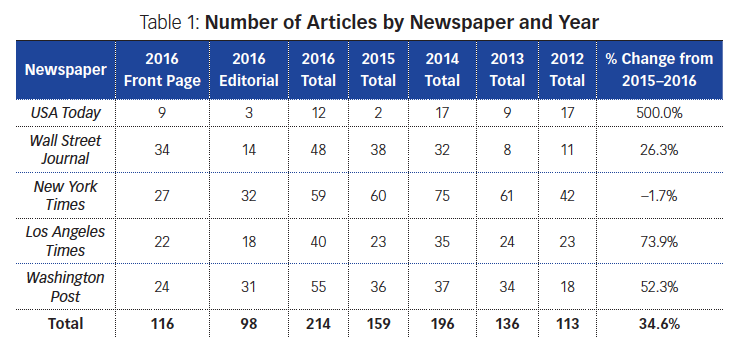
What are the hot buttons?
Figure 2 (see below) identifies the issues most frequently covered in the articles and the frequency of their coverage. High drug prices and drug safety have consistently been among the top hot-button issues attracting coverage, and 2016 was no exception. Articles about drug prices rose to the top of the list, addressed in 55 articles, as shown in Figure 2. Indeed, over a quarter (25.7%) of all stories we tracked last year on the pharma industry discussed drug pricing. Examples include “Another Drug Pricing Ripoff” (Los Angeles Times, August 25, 2016), “Patients Struggle with High Drug Prices” (Wall Street Journal, December 31, 2015), and “The EpiPen Outrage Continues” (New York Times, September 22, 2016).

Drug safety, an issue that typically signals bad news for the industry, has held the number one or two spot on the list in eight of the last nine years. In the latest audit, we identified and tracked a new category of drug safety articles that focused specifically on the opioid crisis. This topic emerged from obscurity in past years to the number two spot on the list, with a count of 40 articles. Combining the pieces focused on the misuse/abuse of opioids with other articles focused on drug safety other than opioids, the two groups accounted for a total of 48 articles focused on drug safety or 22.4% of all articles in the sample. Examples of these include “What Do I Tell My Patients Who Want Opioids?” (Washington Post, June 12, 2016), “Pfizer Agrees to Limit Opioid Marketing” (Washington Post, July 6, 2016), and “OxyContin and Addiction” (Los Angeles Times, May 8, 2016).
When the three media sources-NBC Nightly News, All Things Considered, and Google-were investigated for the top two issues, we learned that they identified the two issues with coverage that spanned the entire year of this audit (October 1, 2015, to September 30, 2016). The range of this coverage is depicted in Table 2.
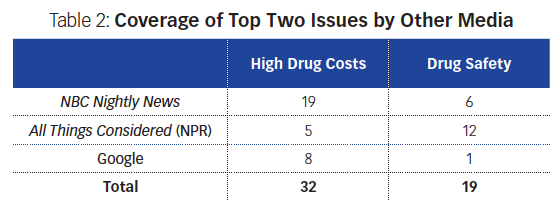
The next two issues on the hot-button list-M&As and tax inversion/evasion-are also overlapping in many cases. While the merger topic has consistently appeared on the list over the years of this study, the specific focus on tax inversion and/or evasion is a newly emerging topic. The tax inversion theme resulted in a mix of articles that offered opposing views on the topic. Examples include “Bring the Corporate Tax Exiles Home” (New York Times, December 14, 2015), “An Rx for Tax Avoidance” (Los Angeles Times, November 25, 2015), and “US Tax Drives Firms Away” (Washington Post, November 9, 2015).
The legalization of marijuana is another issue that emerged from insignificance in 2016. Not surprisingly, the coverage included both pro and con positions with, for example, the Los Angeles Times reporting “Pot Policies Mired in the ’70s” (August 12, 2016) and The Washington Post calling for caution in a trio of articles (“Don’t Reclassify Marijuana Yet-Research It” (August 16, 2016), “One Reason for Cannabis Caution” (July 31, 2016), and “What Needs to Happen Before We Legalize Marijuana” (April 30, 2016).
Articles focused on research and development of new medicines, the issue receiving the most coverage in 2015, fell off from 28 articles to only six last year. Similarly, stories focused on the Ebola virus dropped from 16 to only one. The topic of marketing and sales incentives, which used to attract coverage and was near the top of the list several years ago, fell to just one article in 2016. This lack of coverage is a positive outcome for the industry, and may reflect new policies and procedures in place to regulate incentives to physicians.
Linking pharma firms to the hot issues
For the fourth year in a row, this audit linked specific pharma companies and/or their products to the hot-button industry issues. In 2016, 77 companies accounted for 212 mentions. Of those, Pfizer was mentioned 37 times, with the content centered on price increases for 100 of its drugs, contributing to the 55-article total identified in Figure 2. Another 46 of the mentions were attributable to Allergan and Valeant, each with 23, respectively. Attention was directed to Allergan due to its failed merger with Pfizer, along with a $2 billion decrease in sales. Valeant gained attention by losing $85 billion in valuation and then failing to sell assets as proposed by their new CEO, Joe Papa. Both contributed to the third and fourth issues of M&As and tax inversion/evasion. The remaining 129 mentions, many of which were related to drug safety, were distributed among 74 other companies.
Coverage
Our 13 years of analysis has found that the tone of headlines and articles tends to be more negative than positive toward the industry. In 2016, headline tone was mixed. On one hand, there were fewer positive headlines. In fact, positive headlines hit a five-year low of only 9.8% of all articles. Furthermore, the proportion of negative headlines increased slightly in 2016 to 34.1%. On the other hand, headlines were not as consistently negative in 2016 as they were in the years 2012 through 2014. In addition, more headlines were neutral to the industry (56.1%) as compared to previous years.
In terms of the tone of full-text articles, the trends weren’t as favorable. As shown in Table 3 (see below), only 13.6% of articles took a positive tone toward the industry, the lowest level in the past five years. Likewise, the proportion of articles taking negative positions toward the industry is at a five-year high of 50.5%.
Regardless of whether the article takes a primarily positive or negative tone toward the positions of the industry, our audit analyzes whether both sides of the disputed issue are at least acknowledged. In 2016, 31.8% (68 of 214) of articles mentioned both sides, a drop from 52.8% the previous year.

Analyzing healthcare reform coverage
Consistent with previous years, we analyzed the top five US newspapers and answered the following questions:
- Do the healthcare articles and headlines support or oppose the positions taken by the pharma industry?
- What ethical issues face the pharma industry in these articles on reform?
- How often are the industry’s perspectives included in the articles?
- What pharma companies and/or brand names are identified in the articles?
- What are the implications of these findings for the industry?
Headlines and articles related to healthcare reform were analyzed as positive, negative, or neutral toward the pharma industry. There was a neutral bent to 2016’s headlines, with 86.1% of them neutral (see Table 4 below). When the full articles were assessed, 69.4% were neutral. These results are consistent with results from prior years, but are the highest percentage of neutral headlines in the last five years and the highest percentage of neutral articles since 2013.
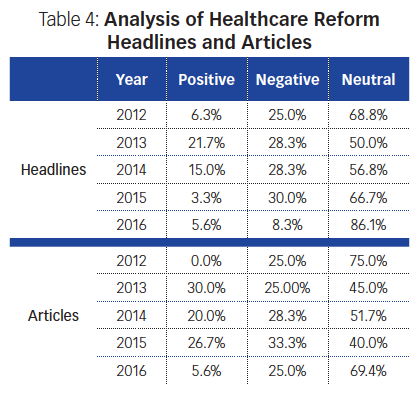
Four of the five newspapers were consistent with the neutral coverage. The exception was USA Today, which published only one article on healthcare reform-and that was negative: “VA Watchdog Great ‘Failure’ to Vets Problems’ Allowed to Fester; Inspector General’s Office Rejected Evidence, Sat on Report, Senate Investigation Finds” (May 31, 2016).
Coverage in 2016 increased slightly from the year before, from 30 to 36 healthcare reform articles. All papers had a least one article and The New York Times and Los Angeles Times had the most coverage with 13 and 11 articles, respectively. Examples include “The Fallacy of the Latest Contraception Case” (New York Times, November 7, 2015) and “End-of-Life Law May Stir Ethical Debates; Cost Controls Emphasize Lethal Pills over More-Expensive Life-Extending Drugs, Medical Experts Say” (Los Angeles Times, October 19, 2015). See Table 5 for a breakdown of the coverage.

Last year’s articles focused primarily on healthcare reform (including the ACA) and, not surprisingly, high drug prices, which were also the top two issues in 2015 (see Table 6 below).
The pharma industry’s perspective was not in the healthcare reform articles. But, as discussed earlier, the link between pharma companies and/or their products and the ethical issues did occur in the articles (77 companies; 122 mentions).
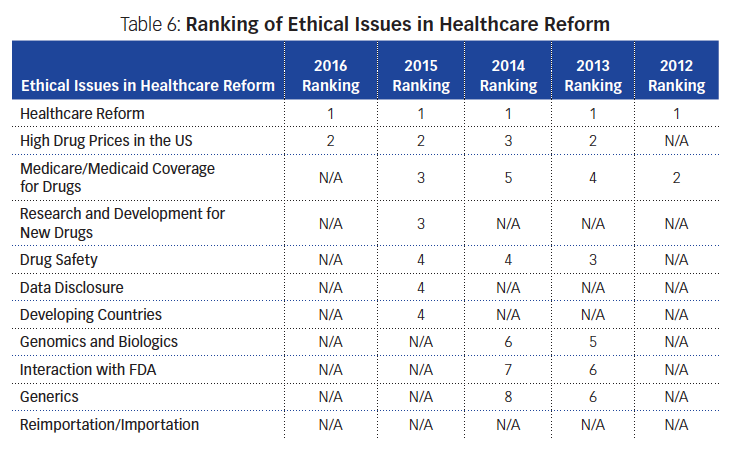
Implications for pharma
As the case in past press audit features, the latest analysis of newspaper coverage of issues that affect drug manufacturers and issues related to healthcare reform has implications for the broader pharma industry. The sector continues to attract attention at a time when it is under scrutiny concerning the pricing of drugs. For example, after announcing that it would increase the price of 100 of its drugs in the fourth quarter of 2016, Pfizer reportedly raised prices an average of 20% between January and June 2017.
Some issues identified in this audit are within the pharma industry’s capability to address (e.g., drug safety) and others are the harbingers of potential future impact (e.g., opioid epidemic). Based on its expertise in the manufacture and distribution of controlled substances, another area where pharma can take a leadership role is the legalization of medical marijuana. Legalization would have an impact on the sale of drugs for which marijuana is an alternative, especially for the Medicare population. The industry is at risk of lost sales as more states approve the use of marijuana for medical purposes.
Finally, the healthcare reform findings suggest an opportunity for pharma to play a greater role in this area. While there is considerable wrangling around the latest version of the reform of the ACA, the industry needs to continue to be proactive in shaping the attempted revisions in healthcare reform. As one of the key stakeholders in healthcare delivery, along with patients, payers, policymakers, and providers, pharma’s actions over the next months can contribute to the stability of US healthcare delivery as Congress wrestles with the latest version of healthcare legislative reform.
George Sillup (sillup@sju.edu), PhD, is Arrupe Fellow & Associate Professor, and Stephen Porth (sporth@sju.edu), PhD, Associate Dean, is Arrupe Fellow & Professor, both at Saint Joseph’s University. Cynthia Slater is SJU’s Business Reference Librarian. SJU students Caitlin Smith, Olivia Capperella, and Claudia Barbiero also contributed to this research.
1. The EthicsTrak database contains assessments of 2,088 newspaper articles evaluated over a 12-year period.
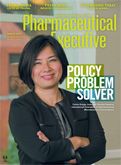
The Misinformation Maze: Navigating Public Health in the Digital Age
March 11th 2025Jennifer Butler, chief commercial officer of Pleio, discusses misinformation's threat to public health, where patients are turning for trustworthy health information, the industry's pivot to peer-to-patient strategies to educate patients, and more.
Navigating Distrust: Pharma in the Age of Social Media
February 18th 2025Ian Baer, Founder and CEO of Sooth, discusses how the growing distrust in social media will impact industry marketing strategies and the relationships between pharmaceutical companies and the patients they aim to serve. He also explains dark social, how to combat misinformation, closing the trust gap, and more.